Assessing Nurse Knowledge of Evidence-Based Catheter Care Guidelines
VerifiedAdded on 2022/10/04
|7
|1697
|95
Report
AI Summary
This report presents a descriptive study design focusing on the knowledge of nurses regarding urinary catheter care guidelines within a hospital setting. The study will be conducted at Hollywood Private Hospital, Perth, WA, across emergency, general, ICU, and acute care wards. The methodology involves a quantitative approach using close-ended questionnaires to assess nurses' conceptual knowledge and a mixed-methods approach for comprehensive data collection, including qualitative data from open-ended questionnaires. Participants include patients over 65 with renal conditions and registered and enrolled nurses over 25. A randomized control trial sampling technique will be used, with NSQHS standards as inclusion criteria for nurses. The recruitment process involves four groups: patients with experienced nurses, patients with usual care, nurses without training, and nurses with training. The study aims to evaluate nurses' knowledge, attitudes, and the impact of training on patient care and CAUTI rates, with the goal of improving nursing education and patient outcomes. The report includes detailed methodologies, participant selection criteria, and recruitment strategies.
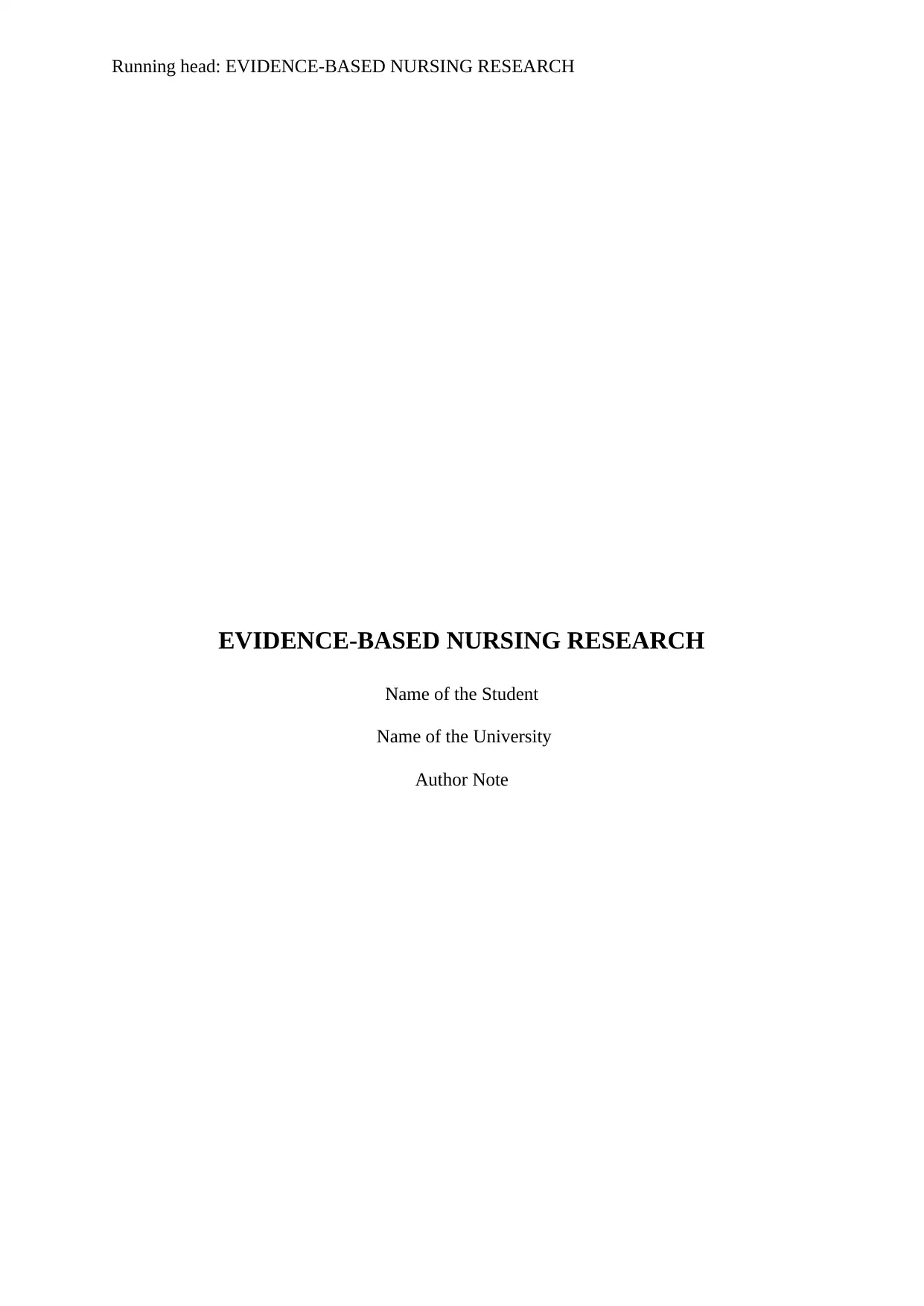
Running head: EVIDENCE-BASED NURSING RESEARCH
EVIDENCE-BASED NURSING RESEARCH
Name of the Student
Name of the University
Author Note
EVIDENCE-BASED NURSING RESEARCH
Name of the Student
Name of the University
Author Note
Paraphrase This Document
Need a fresh take? Get an instant paraphrase of this document with our AI Paraphraser
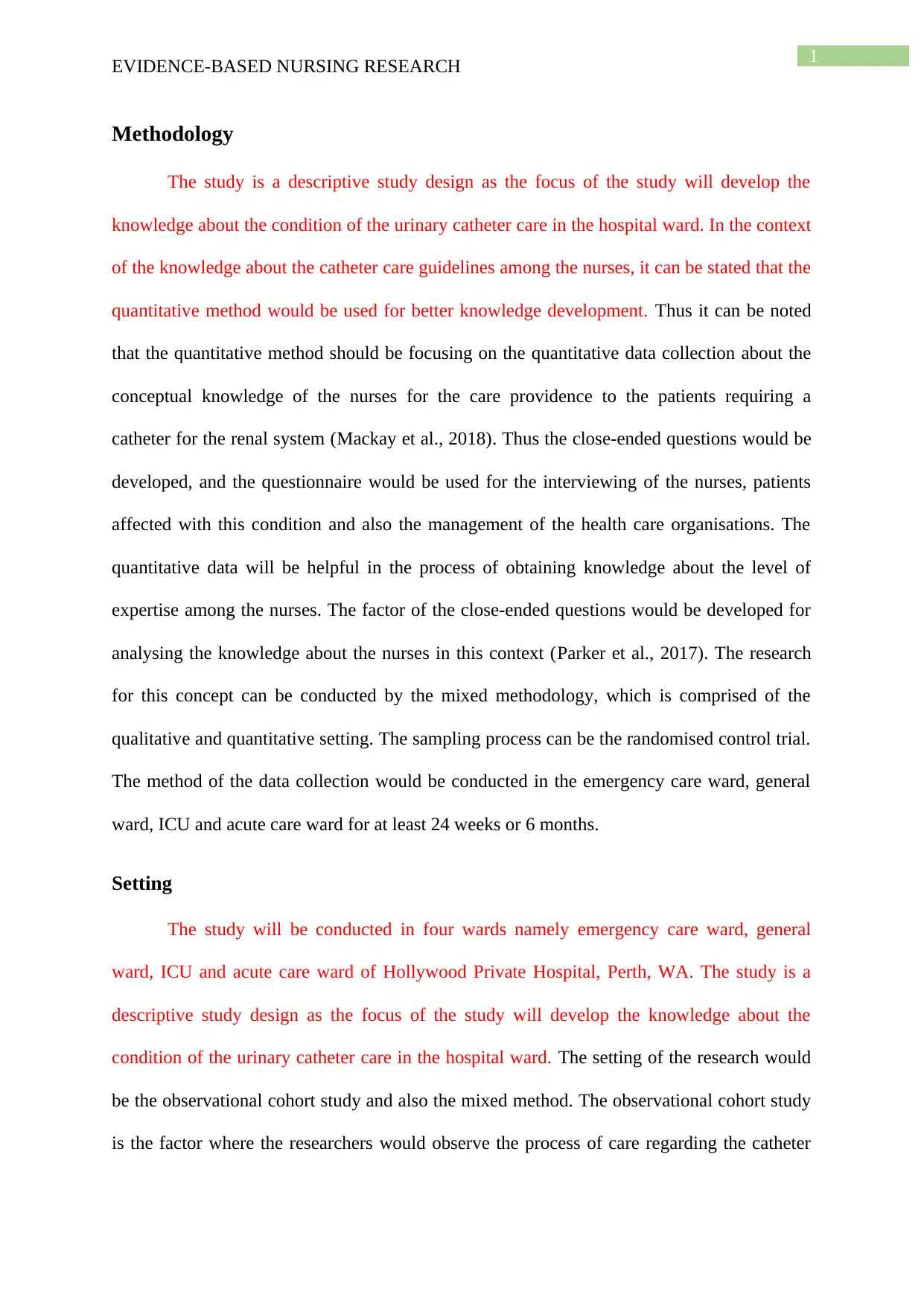
1
EVIDENCE-BASED NURSING RESEARCH
Methodology
The study is a descriptive study design as the focus of the study will develop the
knowledge about the condition of the urinary catheter care in the hospital ward. In the context
of the knowledge about the catheter care guidelines among the nurses, it can be stated that the
quantitative method would be used for better knowledge development. Thus it can be noted
that the quantitative method should be focusing on the quantitative data collection about the
conceptual knowledge of the nurses for the care providence to the patients requiring a
catheter for the renal system (Mackay et al., 2018). Thus the close-ended questions would be
developed, and the questionnaire would be used for the interviewing of the nurses, patients
affected with this condition and also the management of the health care organisations. The
quantitative data will be helpful in the process of obtaining knowledge about the level of
expertise among the nurses. The factor of the close-ended questions would be developed for
analysing the knowledge about the nurses in this context (Parker et al., 2017). The research
for this concept can be conducted by the mixed methodology, which is comprised of the
qualitative and quantitative setting. The sampling process can be the randomised control trial.
The method of the data collection would be conducted in the emergency care ward, general
ward, ICU and acute care ward for at least 24 weeks or 6 months.
Setting
The study will be conducted in four wards namely emergency care ward, general
ward, ICU and acute care ward of Hollywood Private Hospital, Perth, WA. The study is a
descriptive study design as the focus of the study will develop the knowledge about the
condition of the urinary catheter care in the hospital ward. The setting of the research would
be the observational cohort study and also the mixed method. The observational cohort study
is the factor where the researchers would observe the process of care regarding the catheter
EVIDENCE-BASED NURSING RESEARCH
Methodology
The study is a descriptive study design as the focus of the study will develop the
knowledge about the condition of the urinary catheter care in the hospital ward. In the context
of the knowledge about the catheter care guidelines among the nurses, it can be stated that the
quantitative method would be used for better knowledge development. Thus it can be noted
that the quantitative method should be focusing on the quantitative data collection about the
conceptual knowledge of the nurses for the care providence to the patients requiring a
catheter for the renal system (Mackay et al., 2018). Thus the close-ended questions would be
developed, and the questionnaire would be used for the interviewing of the nurses, patients
affected with this condition and also the management of the health care organisations. The
quantitative data will be helpful in the process of obtaining knowledge about the level of
expertise among the nurses. The factor of the close-ended questions would be developed for
analysing the knowledge about the nurses in this context (Parker et al., 2017). The research
for this concept can be conducted by the mixed methodology, which is comprised of the
qualitative and quantitative setting. The sampling process can be the randomised control trial.
The method of the data collection would be conducted in the emergency care ward, general
ward, ICU and acute care ward for at least 24 weeks or 6 months.
Setting
The study will be conducted in four wards namely emergency care ward, general
ward, ICU and acute care ward of Hollywood Private Hospital, Perth, WA. The study is a
descriptive study design as the focus of the study will develop the knowledge about the
condition of the urinary catheter care in the hospital ward. The setting of the research would
be the observational cohort study and also the mixed method. The observational cohort study
is the factor where the researchers would observe the process of care regarding the catheter
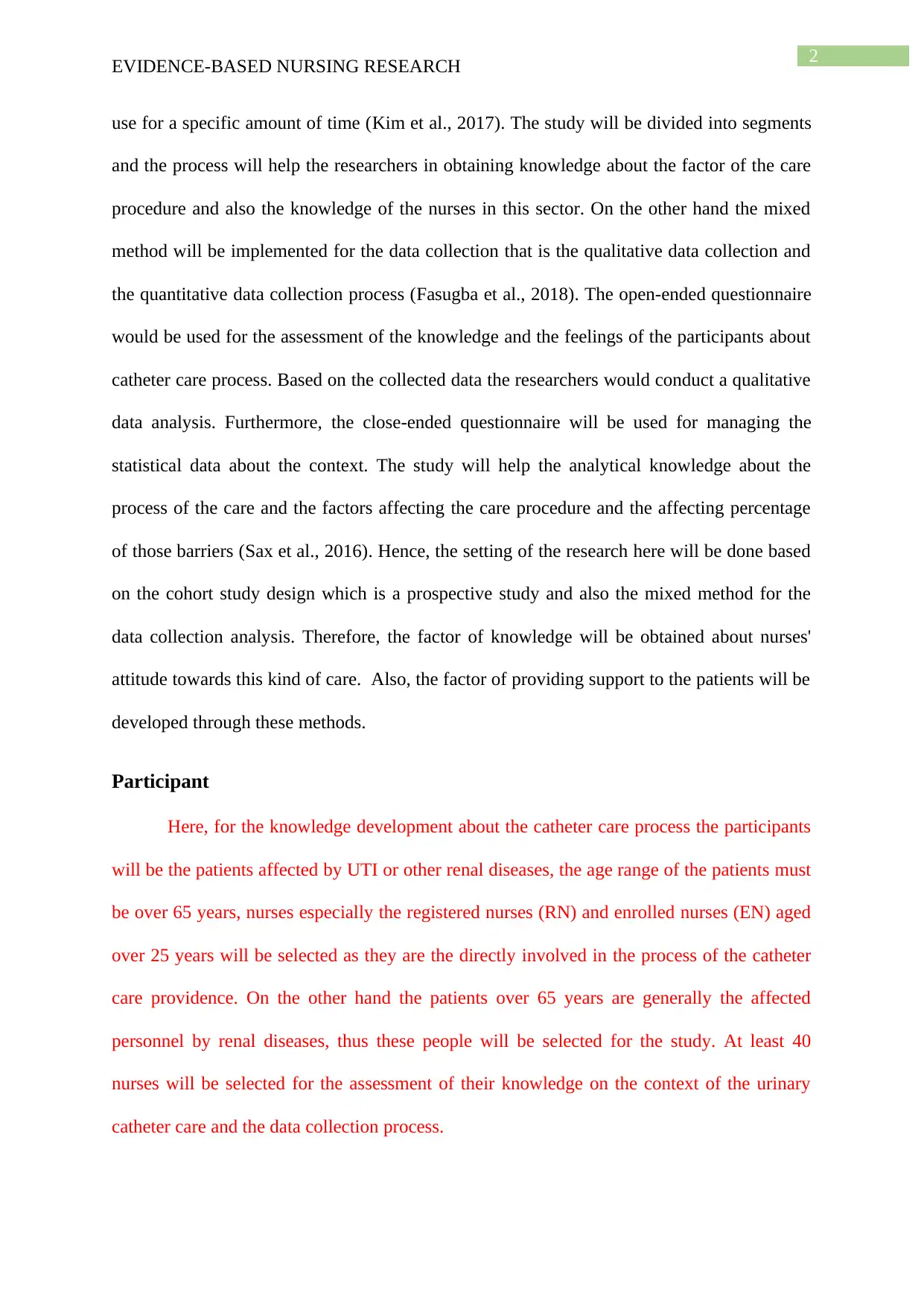
2
EVIDENCE-BASED NURSING RESEARCH
use for a specific amount of time (Kim et al., 2017). The study will be divided into segments
and the process will help the researchers in obtaining knowledge about the factor of the care
procedure and also the knowledge of the nurses in this sector. On the other hand the mixed
method will be implemented for the data collection that is the qualitative data collection and
the quantitative data collection process (Fasugba et al., 2018). The open-ended questionnaire
would be used for the assessment of the knowledge and the feelings of the participants about
catheter care process. Based on the collected data the researchers would conduct a qualitative
data analysis. Furthermore, the close-ended questionnaire will be used for managing the
statistical data about the context. The study will help the analytical knowledge about the
process of the care and the factors affecting the care procedure and the affecting percentage
of those barriers (Sax et al., 2016). Hence, the setting of the research here will be done based
on the cohort study design which is a prospective study and also the mixed method for the
data collection analysis. Therefore, the factor of knowledge will be obtained about nurses'
attitude towards this kind of care. Also, the factor of providing support to the patients will be
developed through these methods.
Participant
Here, for the knowledge development about the catheter care process the participants
will be the patients affected by UTI or other renal diseases, the age range of the patients must
be over 65 years, nurses especially the registered nurses (RN) and enrolled nurses (EN) aged
over 25 years will be selected as they are the directly involved in the process of the catheter
care providence. On the other hand the patients over 65 years are generally the affected
personnel by renal diseases, thus these people will be selected for the study. At least 40
nurses will be selected for the assessment of their knowledge on the context of the urinary
catheter care and the data collection process.
EVIDENCE-BASED NURSING RESEARCH
use for a specific amount of time (Kim et al., 2017). The study will be divided into segments
and the process will help the researchers in obtaining knowledge about the factor of the care
procedure and also the knowledge of the nurses in this sector. On the other hand the mixed
method will be implemented for the data collection that is the qualitative data collection and
the quantitative data collection process (Fasugba et al., 2018). The open-ended questionnaire
would be used for the assessment of the knowledge and the feelings of the participants about
catheter care process. Based on the collected data the researchers would conduct a qualitative
data analysis. Furthermore, the close-ended questionnaire will be used for managing the
statistical data about the context. The study will help the analytical knowledge about the
process of the care and the factors affecting the care procedure and the affecting percentage
of those barriers (Sax et al., 2016). Hence, the setting of the research here will be done based
on the cohort study design which is a prospective study and also the mixed method for the
data collection analysis. Therefore, the factor of knowledge will be obtained about nurses'
attitude towards this kind of care. Also, the factor of providing support to the patients will be
developed through these methods.
Participant
Here, for the knowledge development about the catheter care process the participants
will be the patients affected by UTI or other renal diseases, the age range of the patients must
be over 65 years, nurses especially the registered nurses (RN) and enrolled nurses (EN) aged
over 25 years will be selected as they are the directly involved in the process of the catheter
care providence. On the other hand the patients over 65 years are generally the affected
personnel by renal diseases, thus these people will be selected for the study. At least 40
nurses will be selected for the assessment of their knowledge on the context of the urinary
catheter care and the data collection process.
⊘ This is a preview!⊘
Do you want full access?
Subscribe today to unlock all pages.

Trusted by 1+ million students worldwide
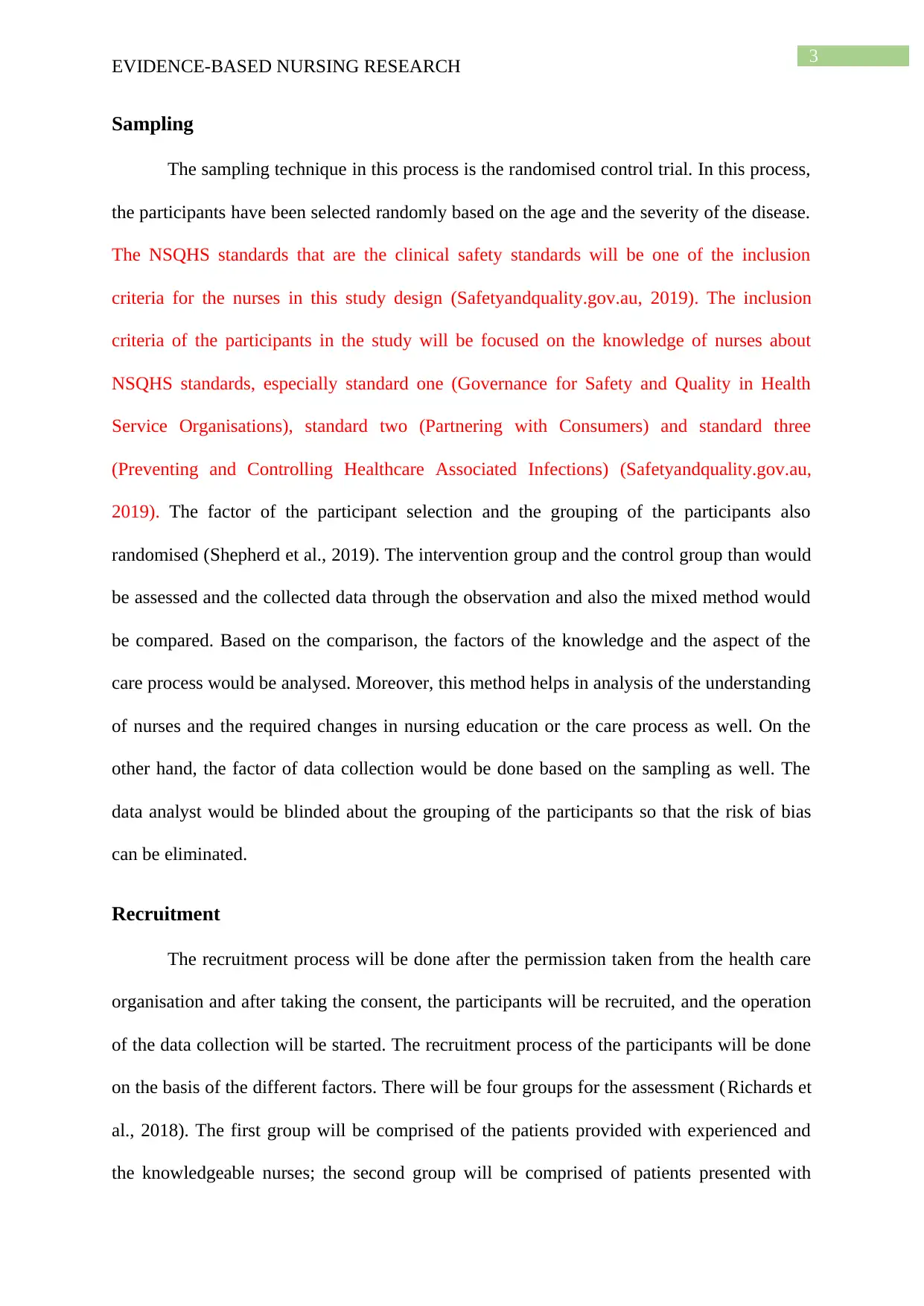
3
EVIDENCE-BASED NURSING RESEARCH
Sampling
The sampling technique in this process is the randomised control trial. In this process,
the participants have been selected randomly based on the age and the severity of the disease.
The NSQHS standards that are the clinical safety standards will be one of the inclusion
criteria for the nurses in this study design (Safetyandquality.gov.au, 2019). The inclusion
criteria of the participants in the study will be focused on the knowledge of nurses about
NSQHS standards, especially standard one (Governance for Safety and Quality in Health
Service Organisations), standard two (Partnering with Consumers) and standard three
(Preventing and Controlling Healthcare Associated Infections) (Safetyandquality.gov.au,
2019). The factor of the participant selection and the grouping of the participants also
randomised (Shepherd et al., 2019). The intervention group and the control group than would
be assessed and the collected data through the observation and also the mixed method would
be compared. Based on the comparison, the factors of the knowledge and the aspect of the
care process would be analysed. Moreover, this method helps in analysis of the understanding
of nurses and the required changes in nursing education or the care process as well. On the
other hand, the factor of data collection would be done based on the sampling as well. The
data analyst would be blinded about the grouping of the participants so that the risk of bias
can be eliminated.
Recruitment
The recruitment process will be done after the permission taken from the health care
organisation and after taking the consent, the participants will be recruited, and the operation
of the data collection will be started. The recruitment process of the participants will be done
on the basis of the different factors. There will be four groups for the assessment (Richards et
al., 2018). The first group will be comprised of the patients provided with experienced and
the knowledgeable nurses; the second group will be comprised of patients presented with
EVIDENCE-BASED NURSING RESEARCH
Sampling
The sampling technique in this process is the randomised control trial. In this process,
the participants have been selected randomly based on the age and the severity of the disease.
The NSQHS standards that are the clinical safety standards will be one of the inclusion
criteria for the nurses in this study design (Safetyandquality.gov.au, 2019). The inclusion
criteria of the participants in the study will be focused on the knowledge of nurses about
NSQHS standards, especially standard one (Governance for Safety and Quality in Health
Service Organisations), standard two (Partnering with Consumers) and standard three
(Preventing and Controlling Healthcare Associated Infections) (Safetyandquality.gov.au,
2019). The factor of the participant selection and the grouping of the participants also
randomised (Shepherd et al., 2019). The intervention group and the control group than would
be assessed and the collected data through the observation and also the mixed method would
be compared. Based on the comparison, the factors of the knowledge and the aspect of the
care process would be analysed. Moreover, this method helps in analysis of the understanding
of nurses and the required changes in nursing education or the care process as well. On the
other hand, the factor of data collection would be done based on the sampling as well. The
data analyst would be blinded about the grouping of the participants so that the risk of bias
can be eliminated.
Recruitment
The recruitment process will be done after the permission taken from the health care
organisation and after taking the consent, the participants will be recruited, and the operation
of the data collection will be started. The recruitment process of the participants will be done
on the basis of the different factors. There will be four groups for the assessment (Richards et
al., 2018). The first group will be comprised of the patients provided with experienced and
the knowledgeable nurses; the second group will be comprised of patients presented with
Paraphrase This Document
Need a fresh take? Get an instant paraphrase of this document with our AI Paraphraser
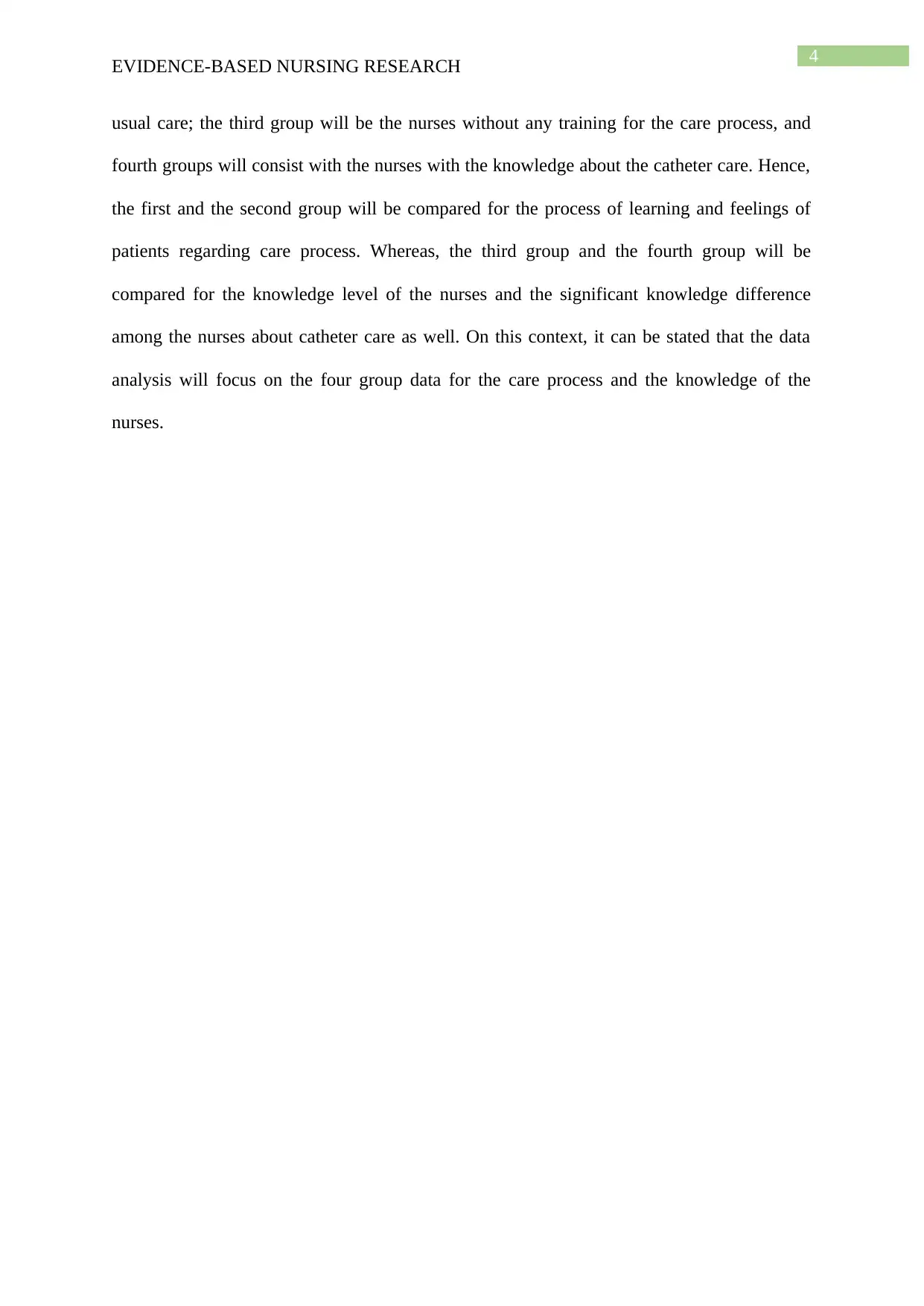
4
EVIDENCE-BASED NURSING RESEARCH
usual care; the third group will be the nurses without any training for the care process, and
fourth groups will consist with the nurses with the knowledge about the catheter care. Hence,
the first and the second group will be compared for the process of learning and feelings of
patients regarding care process. Whereas, the third group and the fourth group will be
compared for the knowledge level of the nurses and the significant knowledge difference
among the nurses about catheter care as well. On this context, it can be stated that the data
analysis will focus on the four group data for the care process and the knowledge of the
nurses.
EVIDENCE-BASED NURSING RESEARCH
usual care; the third group will be the nurses without any training for the care process, and
fourth groups will consist with the nurses with the knowledge about the catheter care. Hence,
the first and the second group will be compared for the process of learning and feelings of
patients regarding care process. Whereas, the third group and the fourth group will be
compared for the knowledge level of the nurses and the significant knowledge difference
among the nurses about catheter care as well. On this context, it can be stated that the data
analysis will focus on the four group data for the care process and the knowledge of the
nurses.
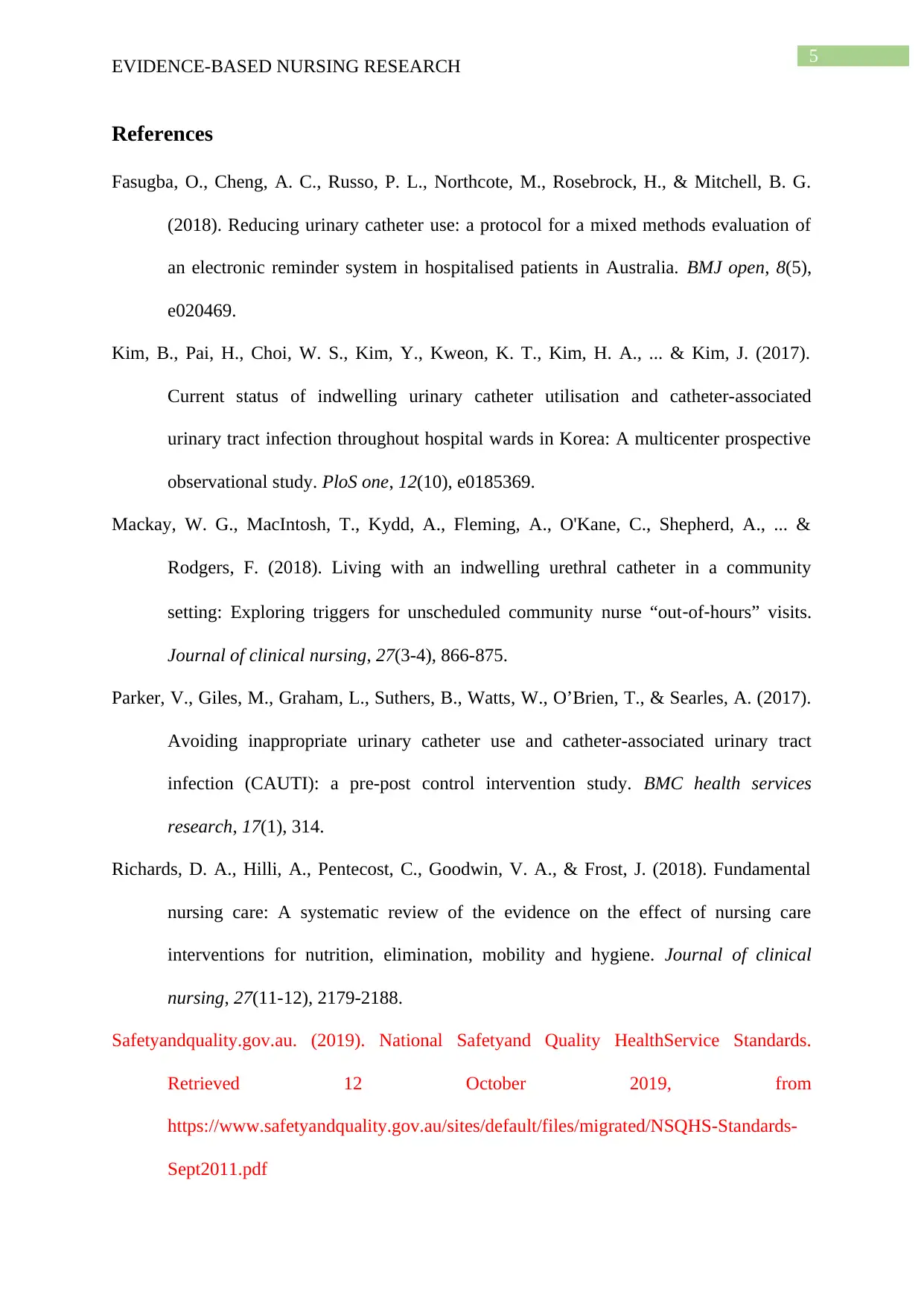
5
EVIDENCE-BASED NURSING RESEARCH
References
Fasugba, O., Cheng, A. C., Russo, P. L., Northcote, M., Rosebrock, H., & Mitchell, B. G.
(2018). Reducing urinary catheter use: a protocol for a mixed methods evaluation of
an electronic reminder system in hospitalised patients in Australia. BMJ open, 8(5),
e020469.
Kim, B., Pai, H., Choi, W. S., Kim, Y., Kweon, K. T., Kim, H. A., ... & Kim, J. (2017).
Current status of indwelling urinary catheter utilisation and catheter-associated
urinary tract infection throughout hospital wards in Korea: A multicenter prospective
observational study. PloS one, 12(10), e0185369.
Mackay, W. G., MacIntosh, T., Kydd, A., Fleming, A., O'Kane, C., Shepherd, A., ... &
Rodgers, F. (2018). Living with an indwelling urethral catheter in a community
setting: Exploring triggers for unscheduled community nurse “out‐of‐hours” visits.
Journal of clinical nursing, 27(3-4), 866-875.
Parker, V., Giles, M., Graham, L., Suthers, B., Watts, W., O’Brien, T., & Searles, A. (2017).
Avoiding inappropriate urinary catheter use and catheter-associated urinary tract
infection (CAUTI): a pre-post control intervention study. BMC health services
research, 17(1), 314.
Richards, D. A., Hilli, A., Pentecost, C., Goodwin, V. A., & Frost, J. (2018). Fundamental
nursing care: A systematic review of the evidence on the effect of nursing care
interventions for nutrition, elimination, mobility and hygiene. Journal of clinical
nursing, 27(11-12), 2179-2188.
Safetyandquality.gov.au. (2019). National Safetyand Quality HealthService Standards.
Retrieved 12 October 2019, from
https://www.safetyandquality.gov.au/sites/default/files/migrated/NSQHS-Standards-
Sept2011.pdf
EVIDENCE-BASED NURSING RESEARCH
References
Fasugba, O., Cheng, A. C., Russo, P. L., Northcote, M., Rosebrock, H., & Mitchell, B. G.
(2018). Reducing urinary catheter use: a protocol for a mixed methods evaluation of
an electronic reminder system in hospitalised patients in Australia. BMJ open, 8(5),
e020469.
Kim, B., Pai, H., Choi, W. S., Kim, Y., Kweon, K. T., Kim, H. A., ... & Kim, J. (2017).
Current status of indwelling urinary catheter utilisation and catheter-associated
urinary tract infection throughout hospital wards in Korea: A multicenter prospective
observational study. PloS one, 12(10), e0185369.
Mackay, W. G., MacIntosh, T., Kydd, A., Fleming, A., O'Kane, C., Shepherd, A., ... &
Rodgers, F. (2018). Living with an indwelling urethral catheter in a community
setting: Exploring triggers for unscheduled community nurse “out‐of‐hours” visits.
Journal of clinical nursing, 27(3-4), 866-875.
Parker, V., Giles, M., Graham, L., Suthers, B., Watts, W., O’Brien, T., & Searles, A. (2017).
Avoiding inappropriate urinary catheter use and catheter-associated urinary tract
infection (CAUTI): a pre-post control intervention study. BMC health services
research, 17(1), 314.
Richards, D. A., Hilli, A., Pentecost, C., Goodwin, V. A., & Frost, J. (2018). Fundamental
nursing care: A systematic review of the evidence on the effect of nursing care
interventions for nutrition, elimination, mobility and hygiene. Journal of clinical
nursing, 27(11-12), 2179-2188.
Safetyandquality.gov.au. (2019). National Safetyand Quality HealthService Standards.
Retrieved 12 October 2019, from
https://www.safetyandquality.gov.au/sites/default/files/migrated/NSQHS-Standards-
Sept2011.pdf
⊘ This is a preview!⊘
Do you want full access?
Subscribe today to unlock all pages.

Trusted by 1+ million students worldwide
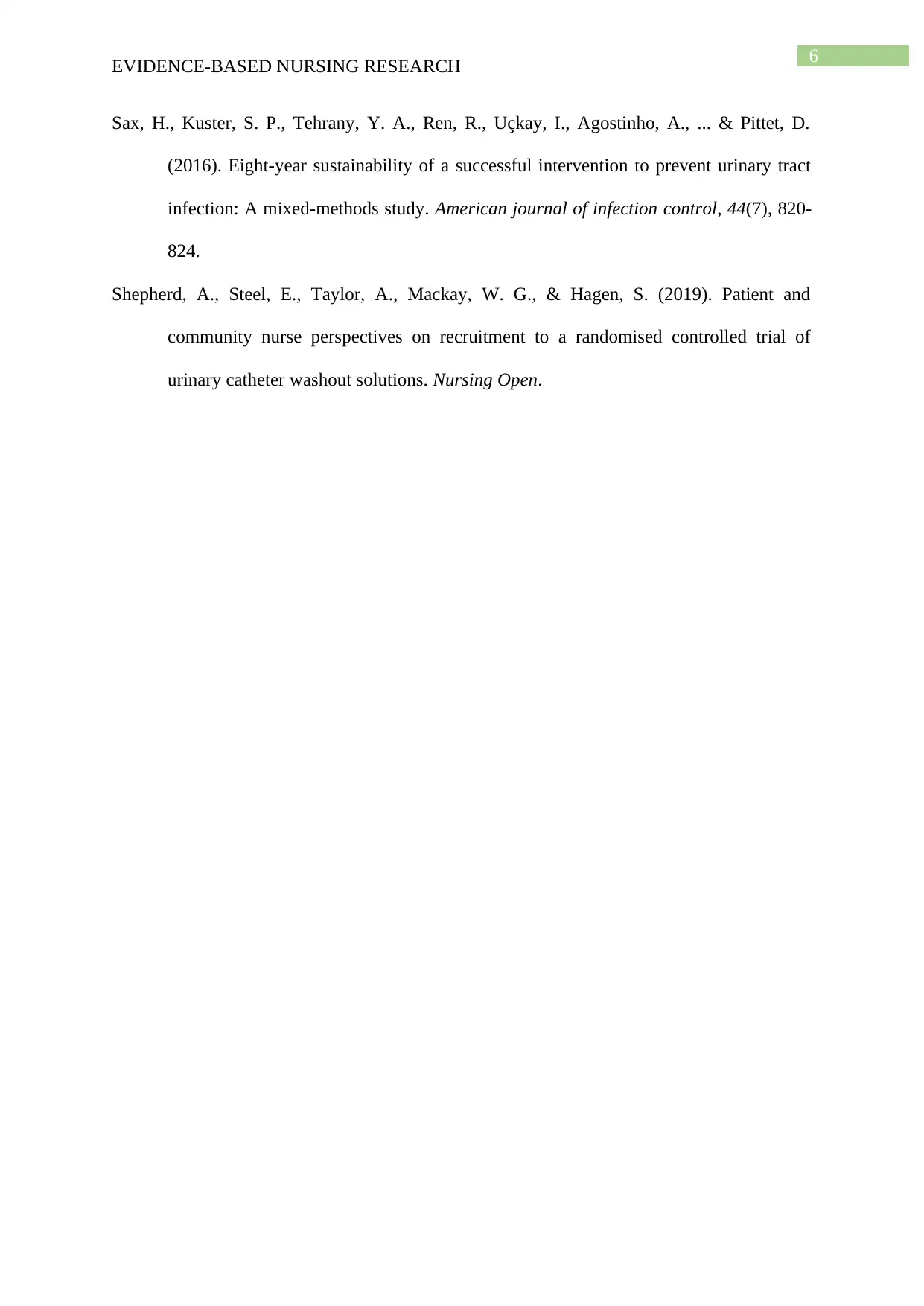
6
EVIDENCE-BASED NURSING RESEARCH
Sax, H., Kuster, S. P., Tehrany, Y. A., Ren, R., Uçkay, I., Agostinho, A., ... & Pittet, D.
(2016). Eight-year sustainability of a successful intervention to prevent urinary tract
infection: A mixed-methods study. American journal of infection control, 44(7), 820-
824.
Shepherd, A., Steel, E., Taylor, A., Mackay, W. G., & Hagen, S. (2019). Patient and
community nurse perspectives on recruitment to a randomised controlled trial of
urinary catheter washout solutions. Nursing Open.
EVIDENCE-BASED NURSING RESEARCH
Sax, H., Kuster, S. P., Tehrany, Y. A., Ren, R., Uçkay, I., Agostinho, A., ... & Pittet, D.
(2016). Eight-year sustainability of a successful intervention to prevent urinary tract
infection: A mixed-methods study. American journal of infection control, 44(7), 820-
824.
Shepherd, A., Steel, E., Taylor, A., Mackay, W. G., & Hagen, S. (2019). Patient and
community nurse perspectives on recruitment to a randomised controlled trial of
urinary catheter washout solutions. Nursing Open.
1 out of 7
Related Documents
Your All-in-One AI-Powered Toolkit for Academic Success.
+13062052269
info@desklib.com
Available 24*7 on WhatsApp / Email
![[object Object]](/_next/static/media/star-bottom.7253800d.svg)
Unlock your academic potential
Copyright © 2020–2025 A2Z Services. All Rights Reserved. Developed and managed by ZUCOL.





